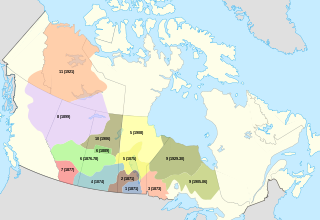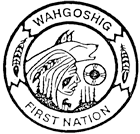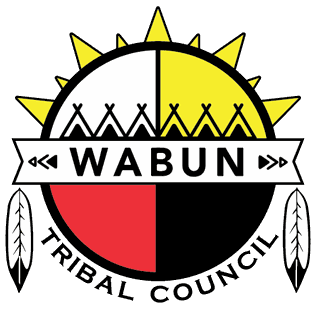Related Research Articles

The Cree are a North American Indigenous people. They live primarily in Canada, where they form one of the country's largest First Nations.

The Ojibwe, Ojibwa, Chippewa, or Saulteaux are an Anishinaabe people in what is currently southern Canada, the northern Midwestern United States, and Northern Plains. They are Indigenous peoples of the Subarctic and Northeastern Woodlands.

McGarry is an incorporated township in Timiskaming District in Northeastern Ontario, Canada. It includes the communities of Virginiatown, North Virginiatown, and Kearns. The township borders with Quebec to the east, along Highway 66 between Kirkland Lake and Rouyn-Noranda. The northern border of the township forms part of the border between Timiskaming District and Cochrane District. Highway 66 was rerouted in 2017 because of concerns that aging mine shafts under the road could cause it to collapse.
A tribal council is an association of First Nations bands in Canada, generally along regional, ethnic or linguistic lines.
Treaty Five is a treaty between Queen Victoria and Saulteaux and Swampy Cree non-treaty band governments and peoples around Lake Winnipeg in the District of Keewatin. Much of what is today central and northern Manitoba was covered by the treaty, as were a few small adjoining portions of the present-day provinces of Saskatchewan and Ontario.

Treaty 6 is the sixth of the numbered treaties that were signed by the Canadian Crown and various First Nations between 1871 and 1877. It is one of a total of 11 numbered treaties signed between the Canadian Crown and First Nations. Specifically, Treaty 6 is an agreement between the Crown and the Plains and Woods Cree, Assiniboine, and other band governments at Fort Carlton and Fort Pitt. Key figures, representing the Crown, involved in the negotiations were Alexander Morris, Lieutenant Governor of Manitoba and The North-West Territories; James McKay, The Minister of Agriculture for Manitoba; and William J. Christie, a chief factor of the Hudson's Bay Company. Chief Mistawasis and Chief Ahtahkakoop represented the Carlton Cree.
First Nations in Manitoba constitute of over 160,000 registered persons as of 2021, about 57% of whom live on reserve. Manitoba is second to Ontario in total on-reserve population and in total First Nation population.
In Canada, an Indian band, First Nation band or simply band, is the basic unit of government for those peoples subject to the Indian Act. Bands are typically small groups of people: the largest in the country, the Six Nations of the Grand River First Nation had 22,294 members in September 2005, and many have a membership below 100 people. Each First Nation is typically represented by a band council chaired by an elected chief, and sometimes also a hereditary chief. As of 2013, there were 614 bands in Canada. Membership in a band is controlled in one of two ways: for most bands, membership is obtained by becoming listed on the Indian Register maintained by the government. As of 2013, there were 253 First Nations which had their own membership criteria, so that not all status Indians are members of a band.

The Little Traverse Bay Bands of Odawa Indians is a federally recognized Native American tribe of Odawa. A large percentage of the more than 4000 tribal members continue to reside within the tribe's traditional homelands on the northwestern shores of the state of Michigan's Lower Peninsula. The historically delineated reservation area, located at 45°21′12″N84°58′41″W, encompasses approximately 336 square miles (870 km2) of land in Charlevoix and Emmet counties. The largest communities within the reservation boundaries are Harbor Springs, where the tribal offices are located; Petoskey, where the Tribe operates the Odawa Casino Resort; and Charlevoix.

Nishnawbe Aski Nation is a political organization representing 51 First Nation communities across Treaty 9 and Treaty 5 areas of Northern Ontario, Canada. Re-organized to its present form in 1981, NAN's original objective was "to represent the social and economic aspirations of our people at all levels of government in Canada and Ontario until such time as real effective action is taken to remedy our problems."

Apitipi Anicinapek Nation, formerly known as Wahgoshig First Nation, is an Algonquin Anicinape community, located near Matheson in Cochrane District in northeastern Ontario, Canada. In January 2008, the First Nation had 270 people registered with the nation, of which their on-reserve population was 121.
Anishinaabe tribal political organizations are political consortiums of Anishinaabe nations that advocate for the political interests of their constituencies. Anishinaabe people of Canada are considered as First Nations, and of the United States as Native Americans.
Brunswick House First Nation is an Ojibway-Cree First Nations in the Canadian province of Ontario, located in the Sudbury District, 157 km (97.6 mi) northeast of Sault Ste Marie, Ontario. The First Nation have reserved for themselves the 9,054.2 hectares Mountbatten 76A Indian Reserve and the 259.8 hectares Duck Lake 76B Indian Reserve. As of June, 2008, it had a registered population of 639 people, of which their on-Reserve population was 171 people.

Wabun Tribal Council is a non-profit Regional Chiefs' Council representing Ojibway and Cree First Nations in northern Ontario, Canada. The Council provides advisory services and program delivery to its seven Status and non-Status member-Nations.
The lack of treaties between the First Nations of British Columbia (BC) and the Canadian Crown is a long-standing problem that became a major issue in the 1990s. In 1763, the British Crown declared that only it could acquire land from First Nations through treaties. Historically, only two treaties were signed with the First Nations of British Columbia. The first of these was the Douglas Treaties, negotiated by Sir James Douglas with the native people of southern Vancouver Island from 1850 to 1854. The second treaty, Treaty 8, signed in 1899, was part of the Numbered Treaties that were signed with First Nations across the Prairie regions. British Columbian Treaty 8 signatories are located in the Peace River Country or the far north-east of BC. For over nine decades no more treaties were signed with First Nations of BC; many Native people wished to negotiate treaties, but successive BC provincial governments refused until the 1990s. A major development was the 1997 decision of the Supreme Court of Canada in the Delgamuukw v. British Columbia case that Aboriginal title still exists in British Columbia and that when dealing with Crown land, the government must consult with and may have to compensate First Nations whose rights are affected.
The following is an alphabetical list of topics related to Indigenous peoples in Canada, comprising the First Nations, Inuit and Métis peoples.
Pelican Lake First Nation is a member of the Federation of Saskatchewan First Nations, the body that represents 74 First Nations in Saskatchewan.
The Lubicon Lake Band is a Cree First Nations band government in northern Alberta, Canada. Missed by government agents during the signing of Treaty 8 in 1899, the Lubicon community was long without federal support. Seeking to have their traditional title acknowledged through the creation of an Indian reserve, Lubicon representatives have maintained an active land claim since 1933. As oil and gas development changed the face of Alberta, development on Lubicon land became an increasingly pressing issue. Between 1979 and 1982, over 400 oil and gas wells were drilled around the community of Little Buffalo, the band's headquarters. Most prominently, the nation mounted a protest campaign during the 1988 Winter Olympics in Calgary, blockading roads crossing its traditional territory in October of the same year.
The Métis Nation of Ontario (MNO) is an organization for people who self-identify as Métis in Ontario. It consists of representatives at the provincial and local levels. On June 27, 2019, the Métis Nation of Ontario and the Government of Canada signed the MNO-Canada Métis Government Recognition and Self-Government Agreement. Herein, Canada recognizes for the first time in history that the Métis communities represented by the MNO hold the inherent right to self-government and self-determination.

Jim Boucher is a Cree and Dene Indigenous Canadian businessman and political leader. As an elected chief, he represented the Fort McKay First Nation (FMFN),. He established the Fort McKay Group of Companies in 1986, and continued to be chairman and president of the Fort McKay Group of Companies (1986–2019), president of the Athabasca Tribal Council (ATC), grand chief of Treaty 8 First Nations of Alberta, vice-chairperson, Board of Governors of Keyano College in Fort McMurray, Alberta, and chairperson for the National Aboriginal Economic Development Board.
References
- 1 2 3 4 Hedican, E. J. (2017). The First Nations of Ontario: Social and Historical Transitions. Canada: Canadian Scholars. p161
- 1 2 3 Ha, Tu Thanh (2017-02-17). "How a Sixties Scoop survivor fought for justice and found her family again". The Globe and Mail. Retrieved 2022-05-05.
- 1 2 3 4 5 Kataquapit, Xavier (25 May 2022). "Historic recognition for Beaverhouse First Nation". timminspress. Retrieved 2022-05-26.
- ↑ Angus, C. (2013). Unlikely Radicals: The Story of the Adams Mine Dump War. Canada: Between the Lines.
- ↑ Giorno, Frank (24 May 2016). "110 years later, Beaverhouse First Nation still has no land chief tells minister". TimminsToday.com. Retrieved 2022-07-26.
- 1 2 "Current land claims". ontario.ca. Retrieved 2022-05-04.
- ↑ "Beaverhouse First Nation achieves historic recognition". The Toronto Star. 2022-05-24. ISSN 0319-0781 . Retrieved 2022-05-26.
- ↑ Courchene, T. J. (2018). Indigenous Nationals, Canadian Citizens: From First Contact to Canada 150 and Beyond. United Kingdom: McGill-Queen's University Press. p63
- ↑ "Urban Indigenous population receiving their vaccines". timminspress. Retrieved 2022-05-05.